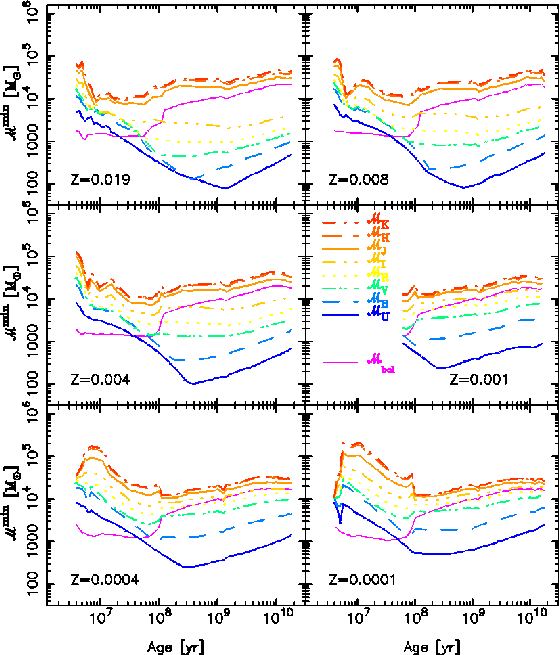Beside the problems related with the track interpolation and the impact of different atmosphere models, there are other unconsiderered problems related with the use of synthesis models.
Maybe, the most trivial Limit for the usage of a synthesis model is the
following one:
The total luminosity of the cluster modeled must be larger than the
individual contribution of any of the stars included in the model
This obvious statement defines a natural theoretical limit for the use of
such models that has not always been considered when they are applied to
real observations. Whereas the original formulation performed by
B. Tinsley did not need to take into account this
limit due to the observational limitations at that epoch, the increasing
sensitivity of current observatories has reached a level where this
limitation plays a fundamental role for a correct interpretation of current
data.
Based on this limitation, we can establish a
Lowest Luminosity Limit (hereinafter LLL, Cerviño &
Luridiana 2003 submitted) for the application of synthesis models
that corresponds to the situation where the total
luminosity of a cluster equals the luminosity of the most luminous
individual star included in the synthesis model. Under this
definition, the LLL is only defined by the used isochrone and the band
under consideration, however its exact value at a given age is also
partially dependent on the star formation history.
Then, for each luminosity band and age, we can obtain a minimal initial
cluster mass,  min(t), for which the total luminosity of the
cluster simulated by a SSP model (with normalized magnitude
mssp) equals the luminosity of the most luminous star in the
band, M*min(t):
min(t), for which the total luminosity of the
cluster simulated by a SSP model (with normalized magnitude
mssp) equals the luminosity of the most luminous star in the
band, M*min(t):

Note that  min depends on the age and the band, but also on
the IMF and the star formation history since integrated quantities depend
on such distributions. The results computed for
In our case, we have used the models from Girardi
et al. 2002, A&A 391, 195 that compute the integrated magnitudes of
SSP models assuming a Kroupa
2001, MNRAS 322, 231 IMF in its corrected version (his Eq. 6) and a
total SSP initial mass equal to 1 Mo in the mass range 0.01 -- 120 Mo. The
results for different ages and metallicities and bands are shown in the
Figure:
min depends on the age and the band, but also on
the IMF and the star formation history since integrated quantities depend
on such distributions. The results computed for
In our case, we have used the models from Girardi
et al. 2002, A&A 391, 195 that compute the integrated magnitudes of
SSP models assuming a Kroupa
2001, MNRAS 322, 231 IMF in its corrected version (his Eq. 6) and a
total SSP initial mass equal to 1 Mo in the mass range 0.01 -- 120 Mo. The
results for different ages and metallicities and bands are shown in the
Figure:

This kind of exercise can be also done for the ionizing continuum, for
example, and establish when the ionization is due to a cluster of ionizing
stars (an hence a representation of the ionizing continuum can be modelized
with a synthesis model) or when the ionization is due to a single star in
the model (and then the ionizng continuum may be better represented by a
single star). A paper on this subject is under preparation.
So, when standard synthesis models fails, it is needed to consider a different aproach: Sinthesis models that include stadistical effects due to the IMF sampling, that is our next subject.


